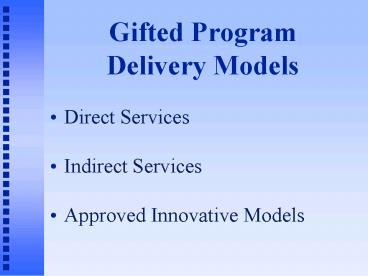Gifted Program Delivery Models - PowerPoint PPT Presentation
1 / 17
Title:
Gifted Program Delivery Models
Description:
May include other high achieving students who meet locally established criteria ... FTE funding generated while away from the regular school campus is awarded to ... – PowerPoint PPT presentation
Number of Views:282
Avg rating:3.0/5.0
Title: Gifted Program Delivery Models
1
Gifted Program Delivery Models
- Direct Services
- Indirect Services
- Approved Innovative Models
2
Direct Services
- Resource Class (K-12)
- Advanced Content Class (6-12)
- Cluster Grouping (K-12)
3
Resource Class (K-12)
- Identified gifted students only
- Limited class size
- Teacher must have the gifted endorsement.
- Academic content foundation but focuses on
interdisciplinary enrichment activities. - Limited to ten segments per week
4
Advanced Content Class (6-12)
- May include other high achieving students who
meet locally established criteria - Maximum total class size 21
- Homogeneously grouped on the basis of achievement
and interest in a core academic content area - No individual student contracts. Course
description and syllabus document appropriateness
of curriculum.
5
Teacher Training for Advanced Content Courses
- AP and IB
- (1) Training from College Board or IB and staff
development training on characteristics of gifted
learners and curriculum differentiation for
gifted students, OR - (2) Gifted Endorsement
- Honors Courses -- Gifted Endorsement
6
Cluster Grouping (K-12)
- Small group of identified gifted students placed
as a group into an otherwise heterogeneous
regular classroom - Teacher must have the gifted endorsement.
- One or two segments per day
7
Documentation of Cluster Group Instruction
- Separate lesson plans
- Individual student contracts that show
- Students NEED for advanced curriculum in that
content area - Learning objectives for the gifted student
- Alternative curriculum activities
- Dates and amount of time student will be engaged
in the higher-level activities - Means by which learning will be assessed.
8
Indirect Services
- Collaborative Teaching (K-12)
- Mentorship/Internship (9-12)
- Joint Enrollment/Postsecondary Options
9
Collaborative Teaching (K-12)
- Direct instruction may be provided by a regular
classroom teacher. - Substantial, regularly scheduled collaborative
planning between the content area teacher and the
gifted specialist
10
Collaborative Teaching, contd
- One full period each day (or weekly equivalent)
that gifted specialist devotes to curriculum
extensions for every three classes in which
he/she has collaborative teaching
responsibilities. - Total number of gifted students whose instruction
is modified through this model may not exceed an
average of eight per class.
11
Documentation of Collaborative Model
- Separate lesson plans
- Time log of collaborative planning
- Individual student contracts
12
Collaborative Model ContractsMust Include
- Students NEED for advanced curriculum in that
content area - Learning objectives for the gifted student
- Alternative curriculum activities
- Dates and amount of time student will be engaged
in the higher-level activities - Means by which learning will be assessed.
- Responsibilities of the gifted education teacher
and the classroom teacher.
13
Mentorship/Internship (9-12)
- One or two segments per day
- Gifted student works with a mentor to
explore a profession of interest. - Gifted education specialist assists
and monitors students(s) to ensure
achievement of
students
individual learning goals - Gifted education specialist must be given one
full period each day for every 15 gifted students
for whom he/she is supervising a
mentorship/internship experience.
14
Internship/Mentorship Contracts Include
- Work to be done
- Learning objectives
- Dates and amount of time the student will
participate - Means by which the students learning will be
assessed - Responsibilities of gifted education teacher and
mentor
15
Joint Enrollment/Postsecondary Options
- Enrollment in college, university, or technical
school may serve as the gifted instruction
districts are required to provide for qualified
students. - FTE funding generated while away from the regular
school campus is awarded to the postsecondary
institution. - Students must meet state regulations for
attendance and be present on the secondary campus
for at least three instructional segments.
16
Individual Student Contracts for Joint Enrollment
and PSO
- Reason(s) why he/she needs a more advance
curriculum than any which could be provided on
the high school campus - Learning objectives for the gifted student
- Dates and amount of time (in segments) the
student will participate in the joint enrollment
arrangement - How learning will be assessed
17
Approved Innovative Models
- Rationale
- Goals and objectives
- Advanced nature of the curriculum
- How effectiveness will be evaluated
- How FTE funding will be generated and documented
- Anticipated fiscal impact































